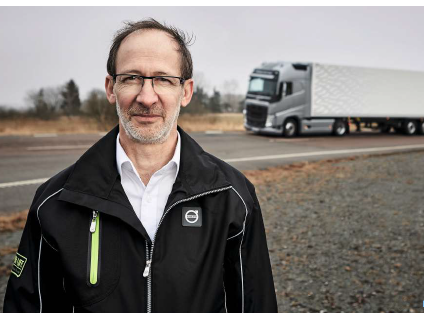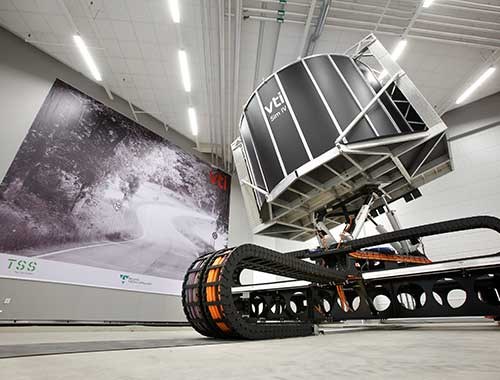Volvo Trucks undertakes European-wide accident study to help reduce road transport injuries and fatalities for vulnerable road users.
The recent research projects focused on the whole question of road safety.
Two major reports have resulted.
One examines various UK and European road user data encompassing accident analy-sis and general road transport data; the second gauges public perceptions towards heavy goods vehicles (HGVs).
Under the direction of Carl Johan Almqvist (pictured), traffic and product safety director at Volvo Trucks, and its Accident Research Team (ART) the first report studied the data and reached a series of conclusions aimed at making European roads safer.
For the second, under the ‘Road Safety is Down to us All’ banner, Volvo commissioned an online study covering a representative sample of 2,095 UK adults including car, lorry, van and bus drivers, motorcyclists and cycle users.
The goal was to understand attitudes towards HGVs, with a particular focus on safety, truck driver behaviour and the truck’s contribution to everyday life.
The ART report is based on Volvo’s own accident investigations and on data from various national and European authorities.
ART has been investigating and analysing accidents involving trucks since 1969, and the team noted in the report: “In the past decade the number of serious road accidents involving heavy trucks has been almost halved in Europe although truck accidents involving vulnerable road users have not been reduced to the same extent.”
About 35% of people suffering serious injuries or fatalities in accidents involving heavy trucks are vulnerable road users and, as noted in the report, with the increasing pace of urbanisation and more people and vehicles on the roads, there is a risk injuries will increase if no action is taken.

More than 26,000 people are killed on European roads every year (and 1.2m accidents – the equivalent to 10 air crashes a day as Volvo put it). Of these, 90% are attributed to human error, 30% environment and 10% the vehicle. Fifteen per cent involve trucks.
The assessment of the accidents, said that while truck and car occupant injuries were reasonably static or decreasing, vulnerable road user injuries/deaths were on the increase from around 20% in 2013 to 35% in 2017.
So it comes as little surprise that one of the report’s main conclusions is the need for greater focus on reducing risks for vulnerable road users such as pedestrians, cyclists, moped riders and motorcyclists.
What does come as a big surprise is the number of European truck drivers who still insist on NOT wearing their seatbelt. “The report reveals that far too many truck drivers don’t use their seatbelts even though we know that half of the unbelted truck drivers who have died in road accidents would have survived, had they been wearing their seatbelts,” Almqvist explains.
Volvo’s ‘Road Safety is Down to us All’ report
This report focused on the perceptions and attitudes towards trucks from all road users and showed one of the main concerns from road users (50%) was not being seen when driving near trucks.
It also found the majority of road users (76%) felt we are all responsible for keeping UK roads safe with 31% saying road users themselves can be the problem as they can view each other as rivals which can compromise road safety.
Unsurprisingly a large number of cyclists (77%) felt unsafe on the roads although many other road users (63%) believe cyclists can be the cause of risk to others.
The public agrees, with 55% saying that cyclists need to take responsibility for their own safety.
Interestingly, half the road users said they expected truck drivers to take greater care in making the road a safer place and this could explain why more than a third believed that due to the lorry size, their drivers seem inconsiderate towards road users.
As for increasing road use, 92% agreed that an increased number of freight services is needed to suit modern life, despite some having a fear of trucks.
The public generally doesn’t feel the same way about the drivers themselves.
Almost all respondents broadly agreed that truck driving requires significant skills and training (96%), with few (21%) showing mistrust in a truck driver’s attention to the road.
Some (15%) have no concern when passing a lorry while even fewer (8%) worry about insecure loads or poorly maintained equipment (4%).
Single roads cause the most fear with 75% feeling more at risk on them than motorways, and almost half agree that dedicated truck lanes are a good idea to improve road safety – something the Government would need to initiate.
But 40% believed the Government is not doing enough to create safer roads. To help road haulage a third of people agreed limitations to road access times for trucks could help by only allowing them on the roads at night.
Training appears to be pitched just right with a balance of those believing truck drivers have sufficient training and those that disagree.

The Volvo Trucks solution
In the first instance, Volvo has been pioneering a number of driver training campaigns – not only for truck drivers but for cyclists and pedestrians under the ultimate goal of zero accidents.
The ‘See and Be Seen’ programme, for instance, which will be rolled out in the UK this year, aims to help vulnerable road users better understand how to interact safely with trucks on the road.
The programme focuses on how important it is for cyclists and pedestrians to make themselves visible to truck drivers and other road users by maintaining both eye contact and a safe distance from the vehicle.
To help, they launched new cabs specifically to improve driver visibility with extra-large windows, slim designs for enhanced rear-view mirror effectiveness and night mode for improved visibility in the dark.
Volvo also has full-size three axis flight simulators-style testing beds to monitor driver behaviour and test intelligent safety systems including:
- Adaptive cruise control, active cruise control
- Collision warning with emergency brake
- Driver alert support
Volvo also believes one of the hot topics – autonomous trucks – brings three key drivers into the equation: productivity, energy efficiency and, importantly, safety.
At a recent event it gave a glimpse of the future for autonomous refuse vehicles with a single driver/operator demonstration based on a Renova body in a mock-up series of streets in the R&D centre complete with wheelie bins.
“The refuse truck we are testing continuously monitors its surroundings and immediately stops if an obstacle suddenly appears on the road,” says Almqvist.
The first time the automated refuse truck is used in a new area, it is driven manually while the on-board system constantly monitors and maps the route with the help of sensors and GPS technology.
The next time the truck enters the same area, it knows exactly which route to follow and at which bins it has to stop.
At the first stop with the automated system activated, the driver climbs out of the cab, goes to the rear of the truck, brings out the wheelie-bin and empties it exactly the way the job is done today by operating the relevant controls.
When the operation is completed, the truck automatically reverses to the next bin upon receiving the driver’s command and the driver walks the same route the truck takes.
“By reversing the truck, the driver can constantly remain close to the compactor unit instead of having to repeatedly walk between the rear and the cab every time the truck is on the move it also reduces the risk of work-related injuries such as strain on the knees and other joints,” says Hans Zachrisson, strategic development manager at Renova.

















Login to comment
Comments
No comments have been made yet.